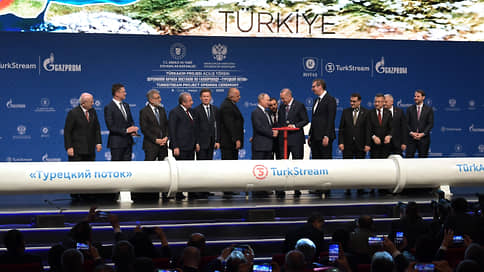The biggest task in history – Newspaper Kommersant No. 190 (7391) dated 10/13/2022
[ad_1]

The Russian authorities are considering expanding gas pipelines across the Black Sea to Turkey in order to redirect supplies there from the blown pipes of the Nord Stream system. According to Russian President Vladimir Putin, a large gas hub could be created on the border between Turkey and the EU. Russia already undertook a similar diplomatic maneuver in 2014, which then made it possible to agree with Germany on the construction of Nord Stream 2. But in the current situation, analysts say, European consumers may not show interest in Russian gas, especially since they will need significant new investments to implement the plan.
Russia is ready to redirect gas flows from the damaged Nord Stream and Nord Stream 2 gas pipelines to Turkey, President Vladimir Putin said at an energy forum on October 12: “TurkStream transports 14 billion cubic meters of gas to Europe. Not that big, but decent. We could move the lost volume of transit through Nord Stream along the bottom of the Baltic Sea to the Black Sea region and thus make it the main route for the supply of our natural gas to Europe, creating the largest gas hub in Turkey.”
sabotage in September, at least three of the four lines of the Nord Stream gas pipeline system were put out of action. Vladimir Putin said that Gazprom is ready to supply gas through the surviving line B of the Nord Stream 2 gas pipeline, but for this the pipe needs to be certified. The German authorities stopped the process on the eve of the outbreak of hostilities in Ukraine. Now Russian gas is supplied to Europe only through Ukraine and via the Turkish Stream.
The condition of the Nord Stream lines is unknown, as the project operator has not yet been able to start surveying them.
Nevertheless, the head of Gazprom, Alexei Miller, said that the restoration of the work of Nord Stream could “take years”, and more quickly, in his opinion, transfer capacities to the Black Sea direction.
The Turkish Stream, which directly connects Anapa with the European part of Turkey, took three years to build. Alexey Miller noted that the gas pipeline “passes through only two economic zones – Russia and Turkey, and the depth there is not like in the Baltic”, apparently meaning that it will be more difficult for saboteurs to get to the new gas pipeline.
It is not clear whether Gazprom has the technical ability to lay such gas pipelines, since the completion of work on Nord Stream 2 by the Russian vessels Akademik Chersky and Fortuna in 2021 took place at a much shallower depth (less than 100 m), and the average the laying speed was several times lower than that of the previous contractor, the Swiss Allseas. The existing threads of the Turkish Stream were laid by the same Allseas, which is now impossible to attract due to US sanctions on all new export gas pipelines from the Russian Federation.
Turkish Minister of Energy and Natural Resources Fatih Donmez said on October 12 that he first heard about this proposal: “We need to discuss some legal, trade and economic issues, technical issues. I think the proposal should be discussed, and this is possible.
This is not the first time Vladimir Putin has used the argument about the possibility of expanding gas cooperation with Turkey in order to strengthen his position in the dialogue with Western European buyers of Russian gas. Thus, after the cooling of relations between the Russian Federation and Europe in 2014, the South Stream project was canceled, which involved laying a gas pipeline with a capacity of 64 billion cubic meters per year from Russia through the Black Sea to Bulgaria and further to Central Europe. Instead, Gazprom decided to lay the Turkish Stream directly to Turkey.
However, six months later, Russia and Germany agreed on the construction of Nord Stream 2, after which the capacity of the Turkish Stream was halved, to the current 32 billion cubic meters. Back in 2015, Turkey itself raised the issue of creating an exchange platform for trading Russian gas on the border with the EU, but at the insistence of Gazprom, these discussions were curtailed, and Gazprom Export later launched an electronic trading platform in Russia to sell gas to Western European customers with delivery mainly via Nord Stream.
Maria Belova of Vygon Consulting notes that Turkey’s first attempts to become a gas hub began with discussions in the late 1980s about the possibility of transiting Qatari gas through the planned Qatar-Iraq-Turkey-Europe gas pipeline. Then the negotiations failed, and Qatar chose to export gas in the form of LNG. Now Turkey has a developed gas transportation infrastructure, the country is striving to become a transit country for Russian, Azerbaijani, Iranian, Iraqi and Central Asian gas.
“In the event of Europe’s political interest, Turkey will be able to provide it with “impersonal” gas, but this will require large-scale investments in the gas pipeline infrastructure in the EU in the “south-north” direction, for which the latter, due to its not very favorable economic situation, may not be ready,” — says the analyst.
According to Sergei Kondratiev from the Institute of Energy and Finance, it is unlikely that European countries in the current situation will be ready to increase purchases of Russian gas through Turkey: it will take years to build new gas pipelines, and the problem of transit countries will remain. Independent expert Alexander Sobko notes that the northern direction of exports from the Russian Federation through the Baltic looks more logical: “Firstly, the main centers of demand are in North-Western Europe. Secondly, in the south, in theory, more alternative sources of gas will appear in the future – Azerbaijan, the Eastern Mediterranean.
[ad_2]
Source link





